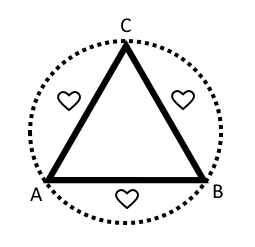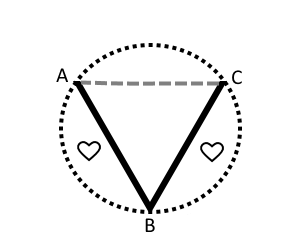Heart farts – part 1/6: The poly time dilemma
If someone suppresses their own erotic level, it not only fosters the chronification of the patriarchal falsehood and, subsequently, Rape Culture, but also secondarily-motivated crushes on new people that the person in question probably would not have developed, or not as easily, had they pursued their sexual desires on the erotic level.
In serial monogamy which stands upon the monogamous fallacy, a wish for a romantic involvement with a new person terminates the pre-existing romantic relationship. Polyamory, however, means that multiple crushes or romantic relationships are possible at the same time. Therefore, the poly ideology stands upon the polyamorous fallacy: The pre-existing romantic relationship remains unchanged (for the moment) while the person who has fallen in love simply adds a romantic relationship with the new person.
As long as they believe in (or don’t openly question) the polyamorous fallacy, the new relationship network of three people remains romantically open. So if another one of the people in the existing polycule falls in love, they add this romantic involvement again, so that now, there are four connected people, either as couples or as metamours. And so on.
In polycules, this leads to constant scheduling problems due to the number of people involved. My boyfriend Nemo has created a mathematical model which I have termed the poly time dilemma:

Key

A couple’s relationship consists of two individuals: Person A and person B. All individuals involved in the couple are the same as those who comprise the whole system of relationships: There is only one mutual space. The complexity of the system is thus simply 1.

A triad is a polycule that consists of three individuals A, B and C in the form of a closed triangle.
- It contains three couples: A+B, B+C, A+C.
- The whole system of relationships is the triad: A+B+C.
The complexity of the system therefore is: 3×1 + 1 = 4.
The examples above do not have any metamour connections. The most frequent form that contains a metamour connection is the V, a polycule in the form of the letter V that consists of three individuals.

It has to be divided into primary and secondary connections:
- Primarily, it consists of two couples: A+B and B+C.
Secondary connections are:
- The metamour connection A+C
- The whole system of relationships A+B+C
The complexity, although there is one romantic relationship less than in a triad, is of equal magnitude: 2×1 + 1 + 1 = 4.
One can argue that metamours spend far less time together than romantic partners do, so why do they get the same weight as a romantic relationship? Anyone who barely speaks with their metamour can certainly round this factor down a bit. However, this value does not only count for the time and energy for direct contact between the metamours, but also for their impact on the connected romantic relationships. Judging from reports of the everyday life of people living in a polycule with a metamour, I derive 0.7 as the lowest value.
For example, the metamours person A and person C must be able to negotiate life decisions as their decisions are both dependent on person B, in order to keep the polycule stable. For this connection to work, they must spend time and energy as well, to build and maintain mutual trust. In addition, metamours contribute directly or indirectly to all conflicts around person B, such as when person A and B have a conflict, and person C cheers up person B afterwards, or when person A mediates in a conflict between person B and person C.
We can deduce that all polycules that consist of three people, irrelevant whether in a triad or in a V, will exhibit the fourfold complexity of a couple. This factor applies to all areas of life which need to occur in a loving romantic relationship: four times more time-consuming, four times the relationship work, four times as many relationship agreements, etc. The more people a polycule contains, the higher its complexity, and thus the necessity for time and energy rises.
This can be shown with an “N”, a polycule consisting of four individuals in the form of a row.

We have individuals A, B, C and D. This constellation primarily consists of three couples: A+B, B+C, C+D. So far, the complexity is only 3×1 = 3. However, there are secondary connections:
- As metamour connections, the lines between A+C, B+D and A+D.
- The whole system of relationships of all four individuals involved: A+B+C+D.
That results in a total complexity of: 3×1 + 3×1 + 1 = 7.
Even if we assume the lower value 0.7 for each metamour, and round down accordingly, the complexity is still 6 which means that it would require the sixfold time, relationship work and agreements of a couple.
If we now perform the thought experiment of a polycule with four individuals, who are not in relationships in the form of a row, but where the polycule completely consists of couples, the situation goes into overkill mode:

Our example shows four individuals, and everybody is in a romantic relationship with everybody else. Every individual is in three romantic relationships. Thus there are no metamour connections, but six couples, four triads and of course one whole system of relationships:
- Six couples: A+B, B+C, C+D, A+D, A+C and B+D
- Four triads: A+B+C, B+C+D, A+B+D and A+C+D
- And the whole system of relationships: A+B+C+D
The complexity is thus: 6×1 + 4×1 + 1 = 11.
This means that it would require the elevenfold time, relationship work and agreements of a couple. Even billionaires who do not have to work at all for their income could not invest that kind of time and resources on a long-term basis. If even further people are added to a poly network, its complexity might ascend to something that would need the hundredfold resources of a couple or more.
The poly ideology, however, claims that a polycule is expandable with further individuals ad infinitum and that this continual expansion is not only a beautiful experience for the individual who enjoys acting upon a new crush, but for all individuals in the polycule. There are numerous statements that polys use to justify this belief, but my personal favourite is the following:
“A relationship is like a candle in a dark room. The more candles I put there, the lighter the room will become and the more fulfilled will I be.”
As detailed above, this will neither work mathematically nor in real life. The realistic consequence of this attitude of an ever-romantically open relationship with ever-new partners is that the individuals involved will soon no longer have the time and energy to provide the attention and emotional work it would need to stay in love. Consequently, after a few weeks, initially energy-giving, loving relationships become largely exhausting, energy-draining connections, which fuel several energy-draining group dynamics between all individuals involved. To stay in the picture, there is not enough time to attend to all the burning candles, until, sooner or later, some flames simply go out, or one falls over and burns down the house.
